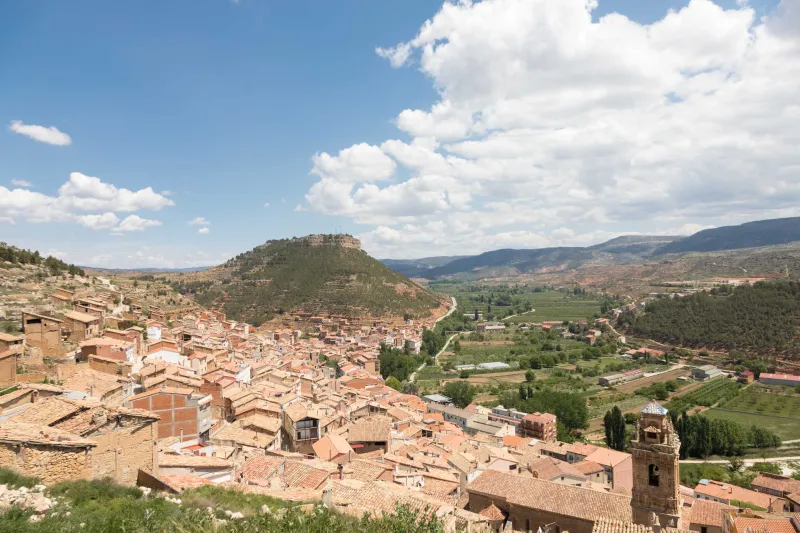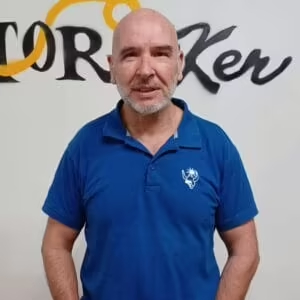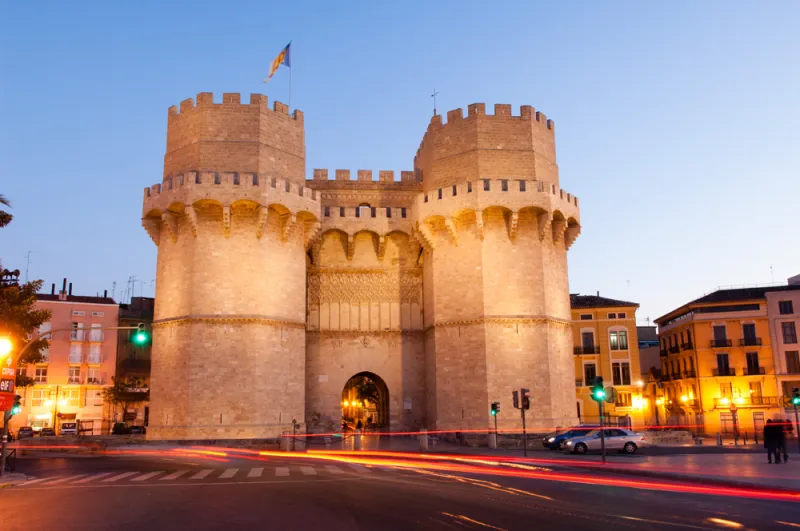
Arrival in Valencia
The first thing we need to do is all meet up. So please plan your arrival in Valencia in such a way — whether by plane, train, ship, bus or a rental vehicle — that we have enough time to pick you up and take you to the hotel (or wait for you there if you’re coming with your own bike), check in and then head over to Toro Biker’s base, just five minutes from the hotel, for the safety briefing at 16:00.
The hotel I’ve chosen for this route is perfectly located: easy transfers from the main arrival points in Valencia and quick access for our rides without having to battle the city’s heavy traffic.
After the safety briefing, we’ll hand out the riding gear for those who need it, and then we’ll go straight to pick up the bikes for those who’ve hired them. At this point, you’ll already feel the adrenaline building in the air.
Once the bikes are sorted, we’ll set off to see some of Valencia’s most iconic spots, starting with a stop and photo at the Torres de Serranos. Together with a now-lost outer wall, these towers were built in the 14th century as one of the city’s four main gates. Today, only two such gates remain: the Torres de Serranos and the Torres de Quart.
Although there were actually up to eight smaller gates giving direct access to various neighbourhoods, the main gates of Valencia’s Christian wall were four, aligned with the city’s cardinal points: the Puerta de Serranos to the north, Puerta del Mar to the east, Puerta de San Vicente to the south and Puerta de Quart to the west.
You may have heard the expression “sleeping under the moon of Valencia.” What you might not know is that it comes from this time, when at night the city gates were closed for security. Anyone arriving after closing time had to sleep outside, under the moonlight.
That’s why “sleeping under the moon of Valencia” came to describe a situation where someone ends up stranded or unable to fulfil even the simplest expectations — like just getting home for dinner, imagine that!
After taking in this monument from Valencia’s medieval past, we’ll make a jump forward in time as we ride the few kilometres to the City of Arts and Sciences (CACS), arriving in the 20th century in just about ten minutes (beat that if you can, McFly!).
Admiring its spectacular architecture — with almost pharaonic ambition by its architect Santiago Calatrava — is in itself an extraordinary visual pleasure.
There are hundreds of details to discover here; I’ll give you just a couple so you see how much care went into every aspect. For instance, the water in the pools is fresh, not salty, by Calatrava’s own decision, so the reflections are sharper and more photogenic. A neat “trick” that makes pictures in this part of the CACS truly spectacular.
If you visit with someone else and wander apart under the arches of the Prince Felipe Museum, thanks to its special acoustics, you can still hold a conversation up to 50 metres away and hear each other clearly — as if you were side by side. Careful, maybe not the best place for private confessions! Haha.
If you’re into these little curiosities, I encourage you to look them up — because these are just two examples.
We’ll continue our little tour until we reach the no less iconic Malvarrosa Beach, the nerve centre of leisure in the city and a proud showcase of our Mediterranean spirit.
Seeing the very light that inspired Sorolla’s most famous paintings is truly a feast for the eyes.
La Malvarrosa blends the city’s tradition and modern edge. It keeps all the charm of its original splendour in its waters and fine sands, while looking to the future with a revamp that’s put it right at the top of quality beach rankings in Spain.
Along the promenade there’s a fountain designed to resemble a traditional lateen sail fishing boat, a tribute to the fishermen of the Cabanyal‑Canyamelar district. It even inspired a similar fountain in the main square by the harbour of Cattolica, Italy. The first time I saw it there I thought, “This fountain looks familiar!” And of course it did — the mayor of that Italian coastal town visited Malvarrosa, fell in love with the imagery of the water display, and commissioned his own version for Cattolica.
It’s a structure of aluminium, marble and granite, with a metal framework that, when the water shoots, creates the illusion of the boat’s hull and sail cutting through the sea. I love both fountains.
By the time we’re done soaking up all this atmosphere, it’ll be dinner time, so we’ll treat ourselves at one of my favourite restaurants in the city. Like most of the hundreds around here, their menus juggle the most traditional Valencian and Mediterranean dishes with true fantasies crafted by the best chefs — it’s honestly a show in itself.
After dinner, we’ll head back to the hotel and rest.
Remember, either tonight or tomorrow morning, you’ll need to move your belongings from the travel bag into your bike’s side cases and top case, packing everything you’ll need for the route and leaving anything else behind to wait for your return.
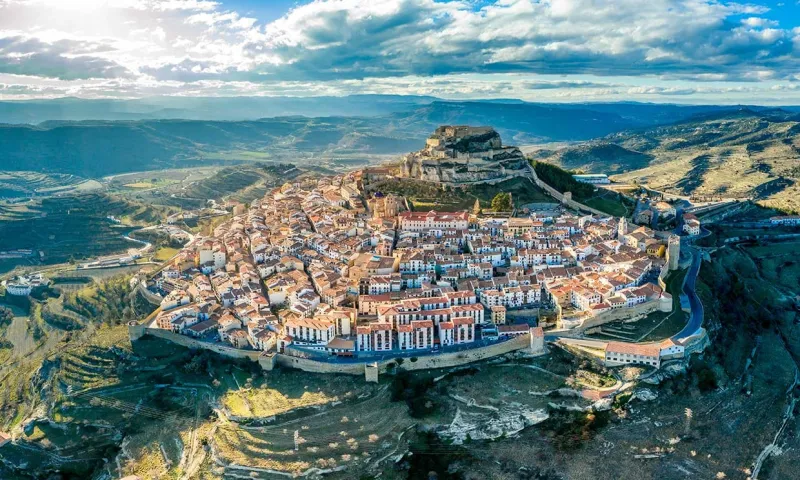
We wake up in Valencia, ready to begin our first day on the road, heading towards the northernmost village in the Valencian Community: Zorita del Maestrazgo. Just the name sounds cool already, right!?
But before we ride out, please don’t forget to transfer your luggage from your travel suitcase to the motorbike panniers. You only need to pack what you’ll use over the next four nights. We’ll collect your main luggage and take it to the Toro Biker Base, where it’ll be safely stored until your return.
All set? Then let’s kick off our guided motorbike experience!
Today we’ll enjoy a route full of twisty roads leading to the cultural highlight of the day: the San José Caves in La Vall d’Uixó.
But first, of course, we’ll stop for one of the most classic biker brunches in the Valencian region: a sandwich of your choice, salad, peanuts (a must!), olives, a soft drink or beer, and to top it all off — a cremaet. Honestly, I have to say this place makes the best cremaet in the whole wide world. Totally subjective, of course!
After brunch, a short ride will take us to the first experience of the tour — and trust me, we’re starting strong.
We’re going to navigate part of the longest underground river in Europe, with more than 2,750 metres explored so far. We’ll cover around 800 metres by boat and another 250 metres on foot, all inside the cave.
It’s a hypnotic experience gliding through crystal-clear waters and illuminated rock formations. The temperature stays constant all year round, between 20 and 22ºC. We’ll float through narrow passages, vast chambers and areas with names like Diana’s Lake, the Bat Room or the Dry Gallery.
The stalactites and stalagmites that fill the caves have taken thousands of years to form, creating stunning natural shapes. Some parts are beautifully lit, enhancing the colours and textures of the rock.
It’s a natural show that’s as serene as it is awe-inspiring. And just so you know — this river has no fish. Since sunlight never enters the cave, there’s nothing for them to feed on. The rest, you’ll hear from the expert guide.
After the caves, we’ll head to another one — this time turned into a restaurant. Here, fresh salads, local starters and traditional rice dishes will fill our table and our stomachs.
The setting — a cave carved into the mountain — is simply breathtaking, and the food is just as impressive. The staff is quick, efficient, and always smiling. I really couldn’t miss the chance to come back to this unique spot.
Once we’ve eaten, we’ll point our front wheels north again for a more relaxed ride towards today’s final destination.
Zorita del Maestrazgo (or Sorita, as you’ll see on some signs) is a hidden gem in the north of Castellón province, near the border with Aragón. It’s the kind of village you might drive past without stopping, but if you do — like we will — you’ll discover a charming place clinging to the rocky slope above the Bergantes River, with terraced houses offering stunning views of the valley below.
It’s a small village, but full of character — narrow lanes, stone houses, and a peaceful atmosphere that slows down time. Here, everything moves at a gentler pace.
We’ll stretch our legs a bit in Sorita before riding along the road that skirts the village, all the way to the northernmost point of our route — right on the border between the Valencian Community and Aragón. There, we’ll take the "NORTH PHOTO", the proof that we’ve completed the first major milestone of the journey.
If your phone allows geolocation on photos, now’s the time to turn it on so the GPS coordinates are saved. If not, we can always add them manually later. The exact spot is roughly here:
40.78603047189196, -0.14615170171695496
I wish we could spend the night in Sorita — I really do. But the only hostal in town, which also serves food, is too small for our group, and the triple rooms just don’t work well for us. So, after a rest and a refresher, we’ll ride down to Morella for the night.
The idea is to arrive with enough time to explore one of the most beautiful villages in Spain — and I’m not exaggerating.
Morella is a stunning medieval treasure that leaves every visitor speechless.
Perched at over 1,000 metres above sea level and surrounded by rugged mountains, it rises like an eagle’s nest, crowned by its imposing castle, visible from miles away. Its 14 watchtowers and over 2 km of walls still enclose the town completely, giving it the appearance of an unbreakable fortress. It was one of the most strategic military spots in the area.
Morella’s castle was key throughout the ages: Iberians, Romans, Visigoths, Moors, Templars… and later, a stronghold in the Carlist wars. Remember, we’re not just “looking at stones” — we’re walking through living history. Legends like El Cid, Pope Luna and King James I himself — who reconquered the town in 1232 — all stayed here. And now, we will too!
Its old town, officially listed as a Historic-Artistic Site, is a maze of cobbled streets, gothic arches, Renaissance palaces and temples that still carry the medieval soul of the town.
Morella still produces honey, sheep’s cheese and black truffle, and is also famous for the manta morellana — a traditional blanket. If you get the chance to buy one, they might even ship it to your home. These blankets are known for being warm and durable, and for my grandparents’ generation, owning one was almost a status symbol. Most people in their 70s or 80s still keep at least one — like a family heirloom.
And now, we’re in for a soulful dinner — one of those that makes you feel at peace with the world.
We’ll sit down with no rush, mission accomplished for the day, ready to enjoy a table full of comfort and tradition.
Morella’s cuisine offers sautéed wild mushrooms with garlic and parsley — most likely picked fresh from the nearby woods that very morning. As the October chill starts to creep in, a hearty olleta morellana (a thick local stew with just the right amount of paprika) will warm your body and soul. And if you’ve still got room, we’ll go for the main course: oven-roasted lamb from Els Ports, crispy on the outside, tender on the inside, served with potatoes and rosemary. Simple, honest, and deeply satisfying. A robust local red wine pairs perfectly.
To finish: flaons — sweet pastries filled with fresh cheese, almonds and a touch of anise. Like a warm memory of a grandmother’s kitchen.
Trust me, this is the kind of dinner you remember not for stars or Michelin labels, but for moments.
And with full bellies and full hearts — we’ll head to bed.
Good night!
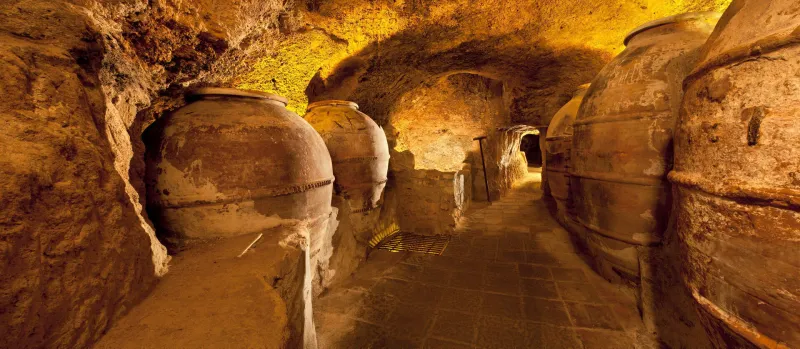
After breakfast, we get back on the bikes and point them west. Our destination today is a village that, while technically part of the province of Valencia, isn’t actually connected to it. Sounds strange? Let me explain…
This morning’s break – time to stretch our legs and grab a cool drink – will be in El Rincón de Ademuz.
It’s one of those places that feel like they’ve been forgotten by time, tucked between mountains and valleys, waiting to be discovered. As I said, it belongs to the province of Valencia, but it’s not geographically connected to the rest of the region. That alone makes it a story worth telling.
El Rincón de Ademuz is a Valencian enclave completely surrounded by land from Aragón and Castilla-La Mancha. So yes, we are in Valencia – and yet we’re not. In fact, you can’t reach the rest of the province from here without first leaving it. A rare geographic quirk that few people know about… and that makes this place truly unique.
Nature here is at its finest: lush green hills, rivers like the Turia and the Bohilgues with crystal-clear waters, forest-lined trails, and winding roads that seem custom-made for the joy of riding. Just our kind of place!
Now’s the perfect moment to turn geotagging back on for our photos – this will be the westernmost point on our journey. One more for the gallery!
After a rest, a drink, and a few snapshots, we ride on – this time heading to Requena, where lunch awaits in one of the most down-to-earth local restaurants. The setting is charming, the flavours are honest, and I honestly believe they serve some of the best grilled meats and sausages you’ll ever taste around here. Throw in a fresh salad and a good local wine, and today’s culinary victory is complete.
Requena is history, wine and personality. Its medieval roots are still alive in La Villa, the historic quarter that crowns the town. Beneath the surface, a network of underground caves tells the story of wine in this region – they were used for making and storing wine long before modern wineries existed. Speaking of wine… we’re in Bobal country – a grape full of character, producing bold reds and surprising sparkling wines. We’ll take a moment to savour them properly.
After dinner, we’ll wander through La Villa, enjoying the narrow lanes, stone archways, noble crests on old façades… and a silence that wraps around everything. Beneath our feet, those ancient wine caves hide centuries of tradition. Will we find a door leading into them?
Now, visiting Requena and skipping the wineries would almost be a sin – but considering we’re on bikes, and let’s be honest, most wine tastings end with you half-drunk (or worse), I hope you’ll forgive me for putting group safety above temptation. I’m sure you understand. We’ll taste some Bobal at lunch, and later we’ll walk to the old quarter – so no one’s missing out, especially not me. Thanks for understanding.
We’ll have the whole afternoon to enjoy the town, sip more wine on the central promenade, have dinner in one of the terrace restaurants, and fall asleep… surely dreaming of more.
Tomorrow, we ride south.
Rest well – good night!
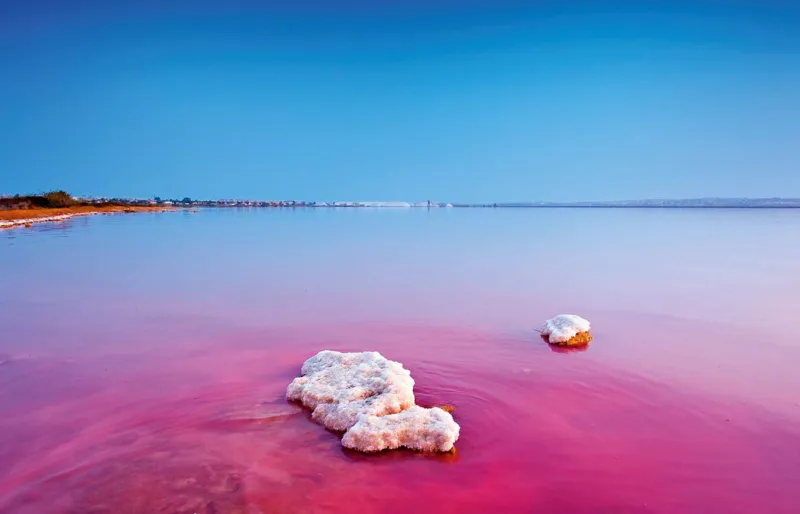
Today we ride south!
After breakfast, we gear up, fuel the bikes and head straight into today’s route — one that takes us through one of the most famous motorbike roads among Valencian bikers: “La Chirrichana”. This section, running through Ayora and Cofrentes, is especially striking thanks to the dramatic view of the nuclear power plant’s towers, constantly releasing clouds of white steam into the sky. A surreal and powerful sight.
“La Chirrichana” is a technically demanding stretch — sharp bends, fast curves, good tarmac and... quite a bit of traffic. That’s why we’re hitting it first thing in the morning, fully focused. It’s possibly the most challenging section of the entire trip in terms of riding skill. But we’re going to love it.
I remember one Saturday ride with the Moto Almuerzo Valencia gang. We were fuelling up before the climb when this skinny older guy showed up — little moustache, receding hair, worn-out leather suit, and a well-travelled Suzuki 600 (I think). He asked if he could tag along with us up the pass. Of course, we said yes.
What we didn’t know was that “can I join you?” really meant “I’m going to leave last, overtake every single one of you with ease, and reach the top first — just in time to head back down to the petrol station and wait for the next group of poor souls.” And that’s exactly what he did. Grinning.
Apparently, he did this all weekend long. Petrol station – overtaking riders up the mountain – back down – repeat. Amazing, right? And then people call you a motorcycle nut. Next time someone says that, you can reply: “Depends who you compare me with...” and tell them this story — because it’s real. I was there. He passed me on the third corner. Imagine if we bump into him again today? That would be insane!
Anyway, after the Chirrichana, the road stays fun but eases up a bit, letting us ride smoothly and enjoy the scenery until lunchtime.
And lunch… well, we’re in for a treat. Expect bold local starters like cured goat cheese (often made with raw milk and naturally aged), traditional cold meats — morcilla (blood sausage), longaniza, chorizo, salchichón — all served with cracked olives and pickled vegetables made with garlic, wild herbs, orange or chili.
If your stomach’s sensitive, be careful with the spicy ones — they burn twice, if you know what I mean! You've been warned.
As for mains, you might try Gachamigas serranas, a rustic stew made with unleavened dough cooked in broth with wild mushrooms and game meat (rabbit, hare or partridge), served with wood-fired bread and flatbreads.
Or go for a classic rice with rabbit and snails — a local icon. Or Pelotas de relleno — large meatballs with breadcrumbs, minced meat, herbs and sausage, all cooked in broth. A heavy hit of protein and fat, yes, but that’s how we roll.
Still not convinced? Then order Trigoentero, a hearty stew of wheat, vegetables and meat, or a Murcian pisto made with tomato, courgette, pepper, onion and egg. So many good choices.
And dessert? Maybe aniseed biscuits, homemade sponge cakes, almond tart or sweet potato pasties… or, if you're lucky, Arrope y calabazate, a thick syrup made from boiled grape must and fruits like pumpkin, figs or melon. After that kind of meal, we’ll need to ride a bit to make room for dinner… or just stick to a salad and some fruit later!
If we survive lunch, we continue riding south all the way to El Mojón — the southernmost village of the Valencian Community — where we’ll get our long-awaited "southern photo". Camera GPS back on!
What’s curious about El Mojón is that it’s split between two autonomous regions: some streets belong to Murcia, others to Valencia. Literally, a single street can have one pavement in each region — with different rules, administrations, services… even different bank holidays!
I bet the locals (yes, they’re called mojoneros) just switch sides depending on which one suits them best that day. I would!
The name “El Mojón” refers to the old boundary marker that once divided the two jurisdictions. And though the official border is well defined, everyday life here is a blend of accents, traditions and quirks. Depending on where the party is, people just cross the street and join in. Classic!
We’ll stop in El Mojón just long enough for the photo, and then head on to Torrevieja for the night — but not before today’s cultural highlight: the Pink Salt Lakes.
The Pink Salt Lakes of Torrevieja are one of the most surreal and photogenic sights on the Spanish Mediterranean coast. If we still used film cameras, we’d burn through an entire roll right here.
Their pink colour comes from a microorganism called Halobacterium salinarum (I looked that up) and an algae called Dunaliella salina (looked that one up too) that thrive in salty water and produce reddish pigments to protect themselves from the sun. Wild, right?
The salt flats have been harvested for over 200 years, but the local salt tradition dates back to Roman times. Today, these lakes are one of Europe’s largest salt producers — for industry, food and even road use in icy countries.
Together with La Mata, the lakes form a protected nature reserve and a haven for migrating birds — including the iconic pink flamingo, visible most of the year feeding in the briny shallows.
The pink hue varies with season, light and salinity. The best time to see it at its most vibrant? Late afternoon in summer or autumn — which is exactly when we’re visiting. It’s going to blow your mind.
After the visit, we’ll check into our hotel and enjoy a stroll through Torrevieja before dinner.
And what a dinner it’ll be. A glorious mix of seafaring tradition, local vegetables and humble dishes elevated over time.
Torrevieja’s cuisine is shaped by its coastal roots and proximity to Murcia — making it rich and full of character.
You’ll likely find Arroz a banda, one of the area’s signature dishes: rice cooked in a rockfish broth, served with alioli and the fish on the side. That’s what a banda means — “on the side”. I’m not usually one for rice at dinner, but I’m not closing any doors.
And don’t miss the mojama (salted tuna), hueva (dried roe), and sardinas saladas — classic bar tapas here. I admit, I love those.
Fish stews like all i pebre de rape (monkfish with garlic and paprika) or cuttlefish and potato stew are also absolute winners.
Torrevieja doesn’t have its own wine DO, but nearby La Mata has small artisan wineries, and the powerful, fruity wines of Jumilla and Yecla are just a stone’s throw away. Our biggest problem tonight will be choosing the perfect wine to pair with our food.
Great food, local wine, and good biker banter — what more could we ask for?
After dinner, with the sound of the waves in the background, we’ll call it a night — tomorrow, another epic day awaits.
Sleep well!
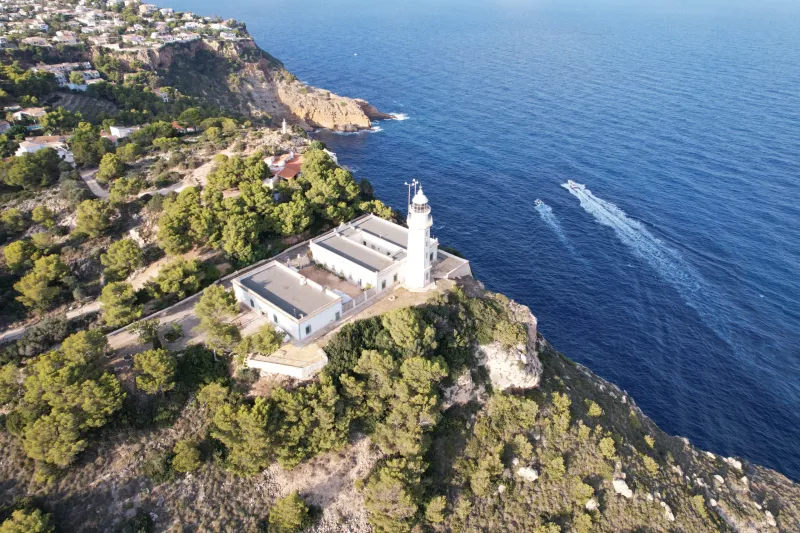
We leave Torrevieja behind and dive into a route that takes us along the edges of the protected landscape of the Sierra del Maigmó and Sierra del Sit—roads that feel like a gift for motorcycle lovers.
Today’s route offers smooth curves and great asphalt, winding through pine forests, almond groves, and high plateaus, with sudden panoramic views over valleys, reservoirs, and distant mountain ranges. In many spots, you can even catch glimpses of the sea on the horizon, adding a scenic bonus to the ride.
The landscape is typically Mediterranean, yet it has a wild, untamed side. Along the route, you’ll ride through dense forests, low shrubs, rocky cliffs, deep ravines, and old farming terraces.
From the heights of Sierra del Maigmó (1,296 m), you get commanding views of much of the Alicante coast, and on clear days, you can even spot Tabarca Island.
Though hard to see, this is wild boar, fox, and genet territory—most active at night. During the day, you might spot booted eagles, buzzards, tawny owls, eagle owls, and if you're lucky, mountain goats perched on rocky cliffs. So as always, keep your eyes on the road—you never know when local wildlife might want a close-up!
Today’s cultural stop takes us to one of the most charming vintage vehicle museums I’ve ever visited: the Guadalest Historic Vehicle Museum.
To talk about this museum is to talk about Ricardo Fracés Seguí. Back in the 1950s—yes, the 1950s—he spent hours at a local blacksmith's shop, watching bicycles, radios, and even shotguns being repaired. That’s where his love for mechanics and restoration was born.
By the age of 13, Ricardo was already riding his dad’s Vespa 125, and at 19, he shared his first motorcycle—a Ducati 175 TS—with his brother. There was no turning back.
Later on, together with his wife and brother, Ricardo opened the restaurant “El Riu.” With the first earnings, he started buying classic motorcycles—like a Montesa Enduro 360 H6 and a Moto Guzzi 65 (which he restored himself)—while scavenging scrapyards and workshops for forgotten gems. His reputation grew, and many people started offering him bikes they no longer used.
After 25+ years of dedication, in 2003 he opened his private collection to the public under the name "Museo de Vehículos Históricos Valle de Guadalest." Since then, everyone lucky enough to visit has been treated to an incredible collection of around 140 restored motorcycles and micro-cars, the oldest from 1944—all in pristine condition with original parts. A true hidden treasure for any motorhead.
And unlike corporate-funded museums, this one was built from the ground up by one man’s passion and effort. No fancy sponsors—just a lifetime love for motorcycles. That, to me, is something truly special. Thank you, Ricardo.
And yes, in case you were wondering—we’re having lunch at El Riu. If we’re lucky, we might even get to chat with Ricardo or his brother.
With that kind of legacy, we simply couldn’t eat anywhere else. But on top of that, the menu offers perfectly grilled meats, fresh salads, delicious starters, and mouthwatering desserts. Prices? Very reasonable. Trust me—today, this is the only place we should be eating.
After lunch, we ride on toward Cabo de la Nao, one of the most iconic and spectacular spots on the Alicante coast—and the easternmost point of mainland Valencia (islands not included, of course). It's an essential stop on this journey. Photo time—here we come!
Get your camera ready—the views from the cliff are breathtaking. On clear days, you can even see Ibiza in the distance.
The cape marks the transition between the Bay of Jávea and the open sea to the south. It’s a dramatic coastline with hidden coves like Cala Ambolo, Cala Granadella, or Cala Blanca, covered in pine forests and coastal shrub. Its seabed is highly appreciated by divers—definitely a spot to bookmark if you're into diving.
We’ll ride our bikes right up to the parking area by the lighthouse. The road is narrow but paved and in good shape. In summer, it can get a bit busy, but for our travel dates, it shouldn’t be a problem.
Photos, sea, nature… another bucket list item checked off!
We’ll backtrack slightly and head to Denia, where we’ll spend the night—and trust me, this might just be one of the most fun nights of the trip.
No early wake-up call tomorrow. You’ve been warned!
We’ll check in, enjoy a dinner full of local delights—after all, we’re in a Mediterranean fishing town. But here, the real star is the Red Prawn of Dénia: rich flavor, juicy texture, simply a must-try. Usually served lightly boiled or grilled. It’s pricey, but worth every bite. And let’s not forget the fresh fish from the local market—gilt-head bream, sea bass, dentex, cuttlefish, octopus… all prepared simply to let the flavors shine. Add a chilled white wine and you’ve got a dinner to remember.
And tonight? After days of behaving ourselves and calling it a night right after dinner—I say it’s time for a little fun, don’t you think?
A night out in Denia wouldn’t be complete without hitting at least one (or more!) of the vibrant bars where live music and Mediterranean vibes take over as the sun goes down.
Of course, anyone who wants to turn in early can go right ahead—we’ll tell them all about it in the morning.
Off to bed with a cheeky smile tonight.
Sleep tight!
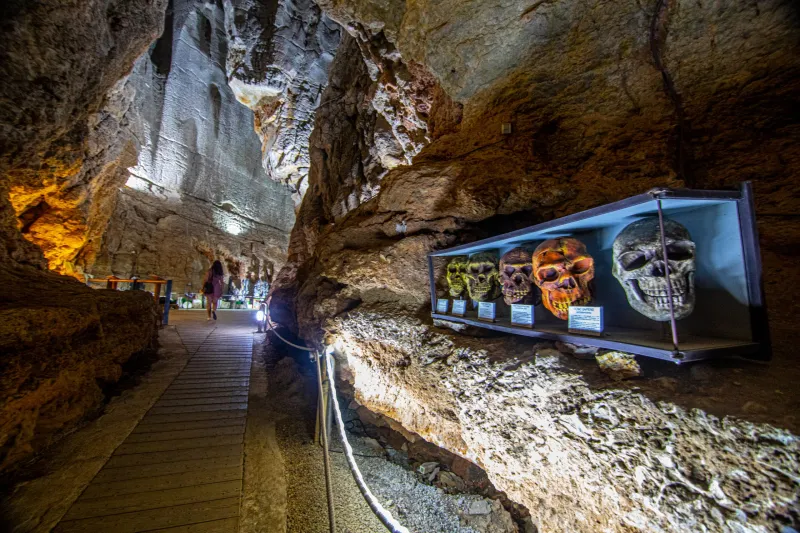
Good morning!
How’s the hangover? Hopefully manageable. If not, a tomato juice at breakfast always helps.
Today, we’re going to stretch our hotel check-out to the limit so we can be on the bikes by 11:00 a.m.—a little extra sleep won’t hurt.
From there, we’ve got a few options, depending on how wild things got last night… you know what I mean.
One option is to visit the Cueva de las Calaveras, a site of major geological, archaeological, and cultural value located in Benidoleig—just 15 km from Dénia, less than a 30-minute ride. Honestly, they’re worth the stop. It’s a stunning natural wonder.
The name comes from the 1768 discovery of twelve human skulls, believed to belong to Muslim farmers who got trapped while trying to collect water—giving rise to the legend that named the cave. Some tales speak of the Moorish king Ahli Moho and his harem trapped inside, but that’s more folklore than fact.
Carved into Cretaceous limestone over 135 million years ago, the cave has galleries with ceilings up to 50–60 meters high and a total length of around 440 meters. It’s been inhabited since the Paleolithic and Neolithic periods—flint tools, arrowheads, and bones from humans and animals like horses, hyenas, rhinos (yes, rhinos in the Mediterranean!), and bears have been found here. Many of these are housed in the Archaeological Museum of Alcoy.
The visit takes just over an hour, and afterward we’ll decide: do we take the scenic inland route to Xàtiva, packed with curves and mountain passes, and continue through twisties to El Palmar? Or do we cruise down the coast through charming seaside towns to our lunch spot? Of course, we could also hit the highway and head straight to El Palmar, no fuss.
Let’s be honest—whether we take the long, curvy route or the smooth coastal one will probably depend on how many cocktails we had last night. Or to put it in biker terms: how much we're in the mood for curves.
El Palmar is a must-stop, and it marks the beginning of the end of our adventure.
This small village, technically part of Valencia and located in the heart of Albufera Natural Park, was once a humble fishing and rice-growing community. Its houses of mud and reeds inspired the famous novel Cañas y Barro by Vicente Blasco Ibáñez.
Traditions still live on here, with boats gliding along canals and festivals like the one for Cristo de la Salud that turn the streets into a celebration of rural Valencian life.
The two signature rice dishes here are Paella Valenciana and Arroz del Señoret.
Paella Valenciana is the most iconic dish of the region—and arguably all of Spain. It was born in the countryside, cooked over wood fires with whatever the farmers had on hand: chicken, rabbit, green beans, garrofó beans, and local rice. Its soul lies in respecting local ingredients and the ritual of sharing.
Do you know what meat was traditionally used in Sueca by the rice field workers? You might be surprised. I’ll tell you over a cold beer and some starters.
Arroz del Señoret is a clean seafood rice dish—no shells, no bones—so the "little lord" eating it doesn’t have to get his hands dirty.
Legend has it that Blasco Ibáñez coined the term to poke fun at well-off young men in El Cabanyal who would only eat seafood if it was peeled and boneless. “Señoritos” didn’t want to get their hands messy.
Today, it’s one of the most popular rice dishes—full of flavor, no hassle. Just dig in and enjoy.
And yes, there’s a rule on how to properly eat paella. I’ll explain that once it's served. It’s a ritual—and hands down, my favorite dish in the world.
Once we’ve devoured both paellas (because yes, we’ll order one of each), we can take a boat ride through Albufera. In October afternoons, the lagoon transforms into a scene of calm, golden beauty.
The air is cooler, the light softer, and migratory birds start to appear. Gliding across the still waters at sunset is pure magic—the golden light reflects off the harvested rice fields, and the only sound is the gentle splash of the oar. A perfect way to end the day in harmony with nature.
We’ll head back to the bikes and ride into Valencia—our starting point, and now the finish line of this amazing ride.
We’re returning to the same hotel from day one, chosen for its location, comfort, and great service.
Our luggage will be waiting there, just as we left it at Toro Biker HQ. You can transfer your things from the bike to your travel suitcase whenever you want—either tonight or tomorrow morning, no rush.
After freshening up, I think we all deserve a truly special final dinner. So tonight, we’re heading to a restaurant with a live flamenco show—ÓLE!
We’ll treat ourselves to the “VIP Excellence” tasting menu, with a preferred table close to the stage for the best view of the show, open bar during dinner, a welcome glass of cava, and options for vegetarians, vegans, and those with food allergies or dietary needs.
Get ready for: Andalusian Rebujito, artisan bread with tomato sauce and olive tapenade, a charcuterie board with Iberian ham and cheese, a fresh greens salad with Valencian orange, goat cheese, crispy onions, cherry tomatoes, citrus vinaigrette and Pedro Ximénez, confit cod with vegetable ratatouille, braised beef cheek in red wine over creamy potatoes, and for dessert, apple tatin with vanilla ice cream and pecans. A toast of cava to end the meal and red or white wine (Rioja or Rueda), sangría, beer, soft drinks or water throughout.
All this accompanied by authentic flamenco singing, guitar, clapping, and dancing—full of soul and passion.
An explosion of sensations to wrap up our motorcycle adventure with a bang.
And if you still have some party spirit left after dinner, we’re in one of the liveliest nightlife districts of Valencia. So why not have a few drinks before calling it a night?
I bet we’ll sleep like babies tonight.
Good night!
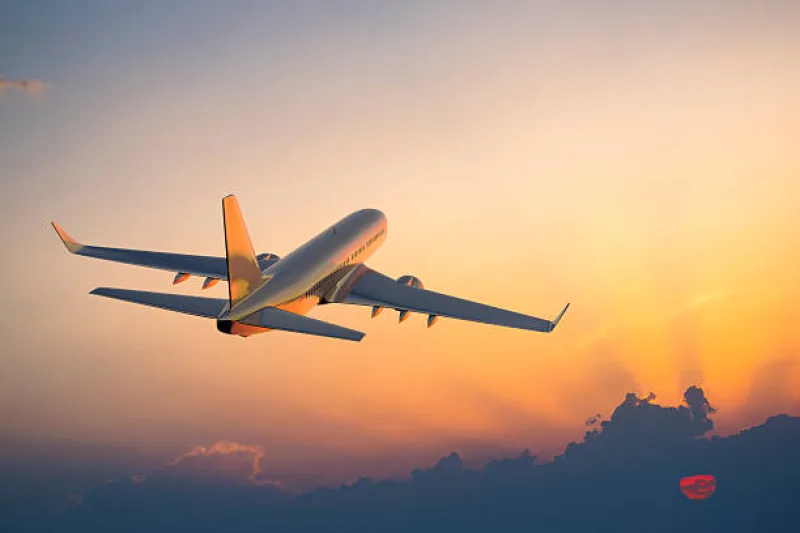
No need to wake up early today—enjoy the pleasure of one more roll under the covers, taking your sweet time before getting up. There's absolutely no rush.
If you rented your motorcycle, we'll head out to return it. Then, by car, we’ll go to the Toro Biker base to drop off your jacket, helmet, and gloves so they can be disinfected in our CO₂ cleaning zone.
If you came with your own bike, I hope the timing lines up with the return of the rentals, so we can say goodbye properly.
There’s an old campfire song that goes, “...the farewell comes, the pain and the parting, but don’t say goodbye…” Let’s go with that and say see you again instead.
For those who arrived by public transport or rental car, we’ll take you back to the same spot where we picked you up on day one.
The experience officially ends only when every single one of you sends a message to the WhatsApp group we’ll have open, confirming you've made it home safe and sound.
If you’ve made it this far and read all the descriptions I carefully crafted for this trip, first of all—thank you for your time. I truly hope you enjoyed it and that I was able to paint a vivid picture of everything we're going to experience.
And more than anything, I hope you agree with me that this route delivers on every promise I set out to achieve: epic roads, breathtaking views, mouthwatering food, deep-rooted culture, meaningful miles, unforgettable moments, lifelong friendships, and of course… motorcycles.
With the satisfaction that comes from a job well done, we bring this experience to a close—and open the road to the memories that will live on in our hearts forever.
I can't wait to make it all come true—with you.
Thank you.









